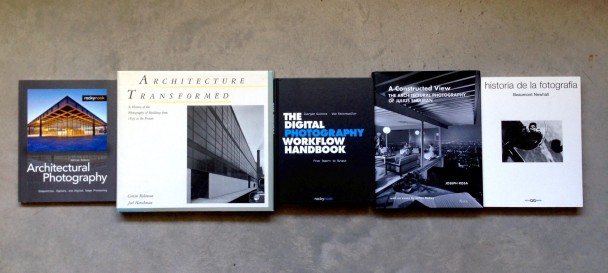5 books to help you learn about architectural photography
Architectural photography is fascinating.
To do it professionally, you need both the technique, which develops with the photographer, and the intuition; a creative intelligence that can convey the meaning of a place that seems devoid of expression. The silky dance of colours, shapes, and textures and the light that painstakingly organises the atmosphere speak to the viewer and give the work its identity. The elements are there, and capturing them in full swing calls for an act of love for what you do: looking for the appropriate conditions, achieving unity, and patiently waiting for everything to emerge, especially what is not immediately apparent. And the process doesn’t end here. Usually, the material needs to be processed. In architectural photography, subtle retouching is acceptable. The photographer must have the necessary skill to adjust the required parameters without going overboard in order to deliver a result consistent with the nature of the commission.
When Marc Torra leaped into the world of architectural photography, he knew he would need certain literary references to educate and consolidate his professional pursuits.
These readings are part of the Fragments collection, and even today they are an inevitable source of inspiration.
- History of photography, Beaumont Newhall (Ed . Gustavo Gili)
It is a definitive, must-read history of the development of photography, spanning from early methods of image recording to the invention of the illustrated press and the introduction of colour. It reveals that rather than merely expressing absolute realities, photography allows us to interpret the world through the lens.
- Architecture Transformed: A History of the Photography of Building from 1839 to the Present, by Cervin Robinson and Joel Herschman (published by The Massachusetts Institute of Technology & The Architectural League of New York)
Since the invention of the daguerreotype, the photographic medium—a sort of cousin to painting and drawing—has given us the opportunity to develop enthralling storytelling languages. This book takes you on a journey back to the moment when architecture and photography first met and explains how they came to co-evolve.
- A Constructed View. The Architectural Photography of Julius Shulman, of Joseph Rosa (published by Rizzoli).
It provides a thorough overview of the photographic-architectural milieu in which we operate. Shulman, who is regarded as the father of the genre, is profiled through his photographic history in the book. There are also hints at the author’s changing life trajectory, including his early move to the country and his discovery of skyscrapers. It narrates the step-by-step journey of a pioneer whose body of work has come under scrutiny from critics who claim that by artificially lighting some scenes, he has compromised the quality of some of his projects. Another reference work is Julius Shulman: The Last Decade, by Thomas Schirmbock (published by Kehrer Verlag).
- Architectural Photography: Composition, Capture, and Digital Image Processing, by Adrian Schulz (published by Rockynook)
This useful book on architectural photography covers the fundamentals of photography for any photographer, including material, technique, formats, position, and perspective. Being able to control them is just as crucial as being able to create resources on the fly that elevate our project.
- The Digital Photography Workflow Handbook: From Import to Output, by Juergen Gulbins and Uwe Steinmueller (published by Rockynook)
Essential user guide for understanding how to coordinate all the elements of the post-production process, from a raw digital file to the delivery of the finished product.
M. Teruel

